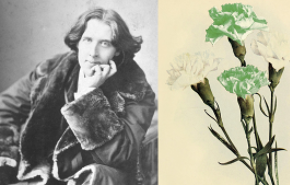It’s a strange, but perhaps expected thing when you start looking to the derogatory stereotypes of the past for validation. In the absence of any other kind of representation, it’s hard not to develop a soft spot for the imperfect representation that, at the very least, exists.
This was the double-edged sword queer cinema scholars like Vito Russo and Parker Tyler had to contend with in writing about the early days of Hollywood. Yes, queer people were present and accounted for in the pre-code days, before Will Hays wiped nearly every kind of LGBTQ+ representation off the screen, but they still had to be shrouded in stereotypes.
If you were every wondering exactly what those stereotypes looked like, look no further than this magnificent sissy supercut made by the YouTube Channel “Watching Classic Movies.”
Culture, unfiltered
Twice a week, our newsletter will bring you the pulse of queer culture, from the tastemakers to the groundbreakers.
If you ever wanted to see the full range of sissies pre-code Hollywood had to offer, here it is in glorious black and white. We see the cartoon caricature of “pansy” in 1933’s “Soda Squirt,” the rouged, lipsticked Tyrell Davis as the all-but-out-gay character Ernest in 1933’s Our Betters, two femme twinks singing a delightful song in a gay club in the 1932 Clara Bow vehicle Call Her Savage, as well as several appearances from Preston Sturges stock character and sometime “professional sissy” Franklin Pangborn.
All these characters are bound together by a few distinct traits: they speak with a lisp or affectation, they show up in upper-class drawing rooms or backstage in Broadway shows, and they are often very outspoken about their admiration for hot men. When straight characters react to them, it’s usually through a mix of gleeful mocking or embarrassed eye-rolling.
Related:
This randy Victorian slang term is just too gay to function
Is he saying what I think he’s saying?
Obviously it’s not great, but it was something. And after 1933, even that tiny something disappeared.
“If [Franklin] Pangborn and the others were indeed ‘supposed’ to be playing homosexuals, they were doing so with little consciousness of that fact,” Vito Russo wrote in his groundbreaking study The Celluloid Closet. “Their sissies were often the most charming and winning aspects of [American] films and regularly saved them from mediocrity.”
You heard it here first: gays have been saving movies from mediocrity since 1897. Before that time, we were saving theater from mediocrity. You’ll notice that in these depictions of “sissies” from 1929-1933, one stereotype persists, and it carries with it a haunting reminder of just what used to happen to gay men who wore their sexuality on their sleeve. Consider the illustration of the queer character in “Soda Squirt.” He’s drawn with cupids-bow lips, long eyelashes, and a handkerchief. He’s also dressed entirely in formal wear, as if about to go to the theater. Similar to many “upper class” queer characters, he’s created to resemble the person who was, at that time, the most famous gay person in history, Oscar Wilde.
Related:
Green is the Gayest Color
An exploration.
Because that’s the uncredited source that many of these caricatures draw from: whether it’s a rouged mouth or a carnation or pansy in the lapel or a few utterings of “dear boy,” we know exactly who’s being parodied. Oscar Wilde was transformed into an anti-gay stereotype while he still lived, courtesy of Punch magazine and the many detractors who felt the need to take away Wilde’s cultural power by labelling him a “sissy.” It might have worked in the short term—Wilde was sent to prison and died an early death—but in the early film stereotype of the “sissy,” Wilde’s influence lived on.
So it’s hard not to look at the innocence of these stereotypes and see something weirdly sweet, even if it wasn’t intended to be. “Their effeminate demeanour was presented for laughs and ridicule,” the supercut explains, but “while these characters were meant to be mocked, they triumphed in their own way.”
That they did. That they continue to do.
Don't forget to share:
Help make sure LGBTQ+ stories are being told...
We can't rely on mainstream media to tell our stories. That's why we don't lock our articles behind a paywall. Will you support our mission with a contribution today?
Cancel anytime · Proudly LGBTQ+ owned and operated
Read More in Culture
The Latest on INTO
Subscribe to get a twice-weekly dose of queer news, updates, and insights from the INTO team.
in Your Inbox
















